This Japanese Cheesecake is the most requested Japanese recipe on Nagi’s post ‘Request A Recipe!’. It’s light, fluffy, moist and less sweet than any other cheesecakes.
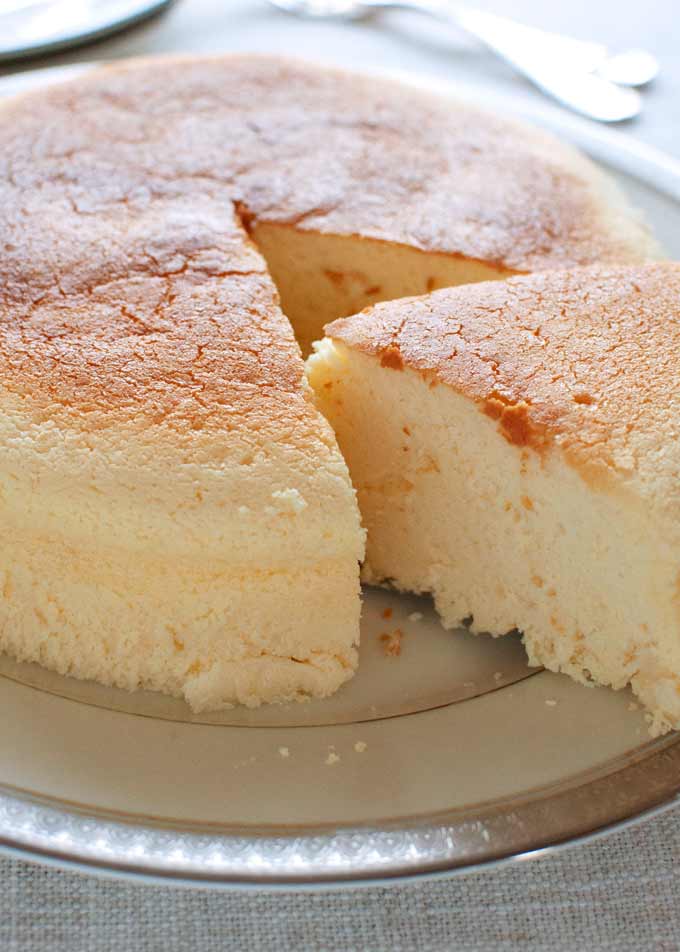
After reading hundreds of recipe requests from the readers, Nagi told me that there were quite a few recipe requests that fell under my expertise, i.e. Japanese dishes. So, I went through all the comments.
I did not know this Japanese baked cheesecake was called Cotton Cheesecake because in Japan, it is called soufflé cheesecake or baked cheesecake. This is exactly the same cheesecake that I made a long time ago using the recipe from my 40-year-old cookbook (photos below). And it says ‘baked cheesecake’.
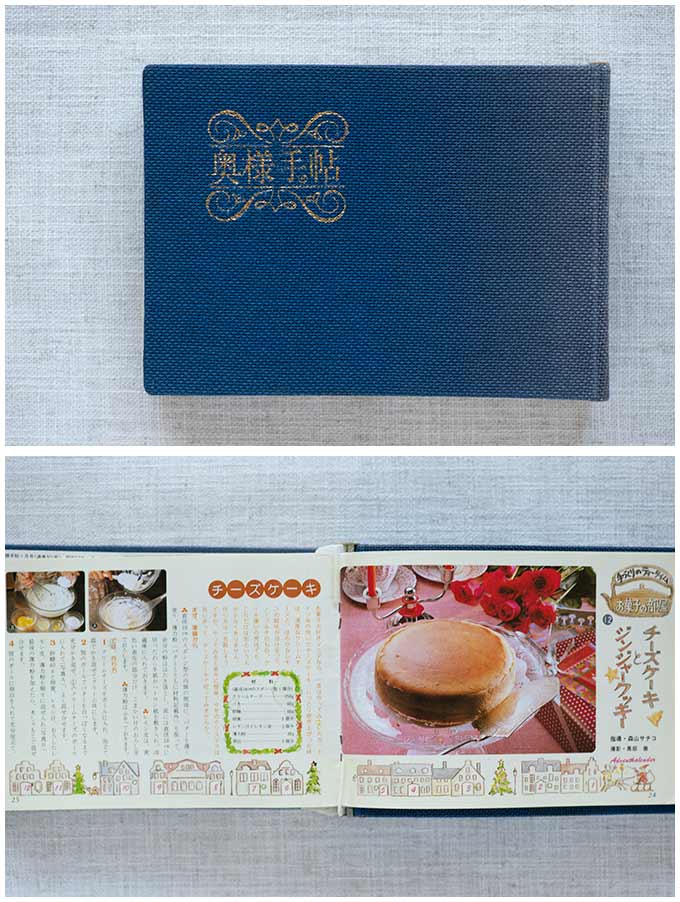
I am aware that there is a different kind of baked cheesecake that is not as fluffy as this Japanese Cheesecake and is much richer. Nagi has posted a recipe like this – Easy Classic Baked Cheesecake.
I like the fluffy texture of Japanese cheesecake. It is quite different from conventional baked cheesecake. It’s almost between a sponge cake and a cheesecake. It is very light and, to my delight, not so sweet either.
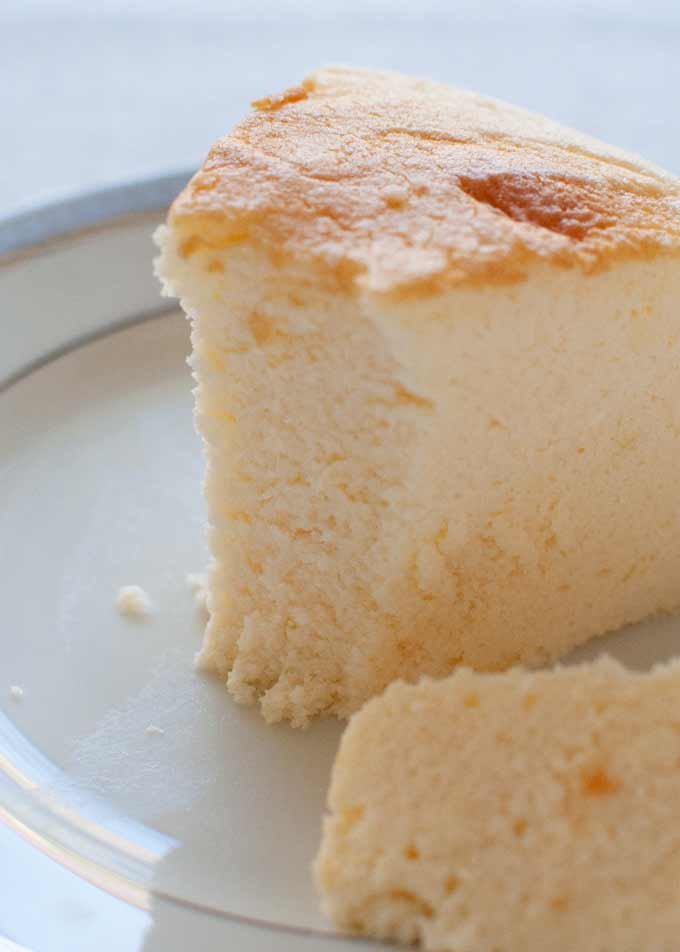 Why So Light?
Why So Light?
If you look at the ingredients of this cheesecake, it is obvious. To make 8 servings of a cheesecake in a 18cm round cake tin, dairy products included in this cake are:
- 250g (8.8oz) cream cheese
- 60g (2.1oz) butter
- 2 tablespoons milk
- 3 eggs
I used only 70g (2.5oz) of sugar so the cheesecake is very light in sweetness, too. My old recipe called for 60g sugar. But when I made this cake per the old recipe and asked my kids to taste test it, I was told that more sugar was required. Nagi said double the sugar (no, thanks!) and my son said OK but just a tiny bit more sugar. And I took my son’s advice.
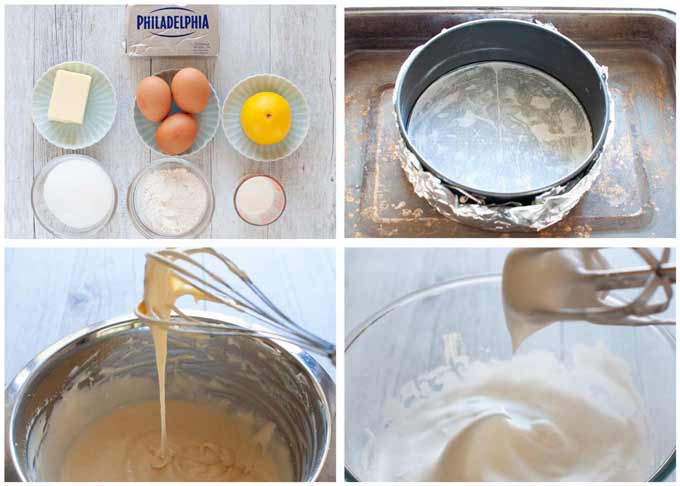
I know that many recipes on the web use a lot of sugar to make Japanese Cheesecake. But I think that for this particular cheesecake, less sugar suits better. Everything about Japanese Cheesecake should be ‘light’.
Adding a tablespoon of lemon juice and some zest gives the cake a refreshing taste, too.
The fluffy and light texture comes from the meringue. Egg whites are beaten with some sugar to make soft peak meringue, then mixed with the batter made from the above ingredients.
My Cotton Cheesecake is perhaps not so jiggly as soufflé since I developed this recipe based on my old cookbook. But it’s still soft and tastes great.
Baking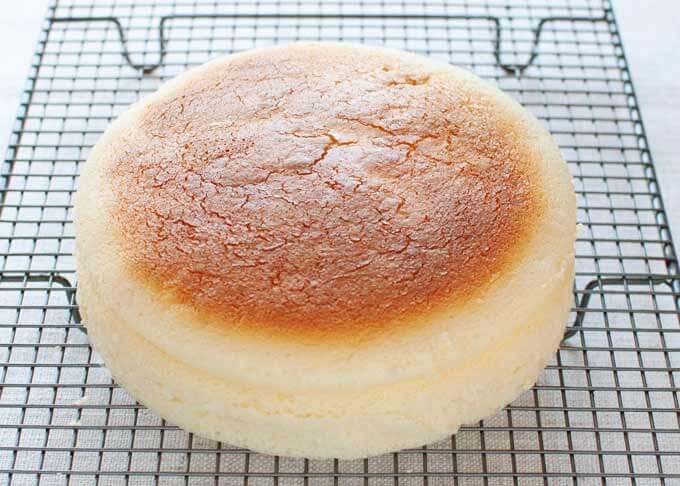
There is a bit of science applied here to make a fluffy moist cheesecake:
- The meringue needs to have a soft peak. Do not beat the meringue too much and form a hard peak. When you make a peak in the bowl by lifting the whisker, the peak should slightly bend.
- Bake at low temperature for a long time. Initially bake at 160C (320F) for 20 minutes, then at 140C (284F) for 40minutes. This prevents the surface of the cake from cracking.
- Bake in a water bath. When baking for a long time, the cake tends to dry up. The water bath keeps the cake moist.
- Lay an extra baking pan underneath the water bath. Along with the 2nd point above, this is also a tip to prevent cracking the surface.
- After turning off the oven, leave the cake in for 30 minutes, then gradually cool down with the oven door open for another 20 minutes. The inflated cake collapses badly when it is suddenly cooled down. The cake also continues to cook in the oven after turning off.
In total, it takes close to 2 hours in the oven before taking the cake out to cool down on a rack. But it’s worth it if you want to make a perfect fluffy Japanese cheesecake.
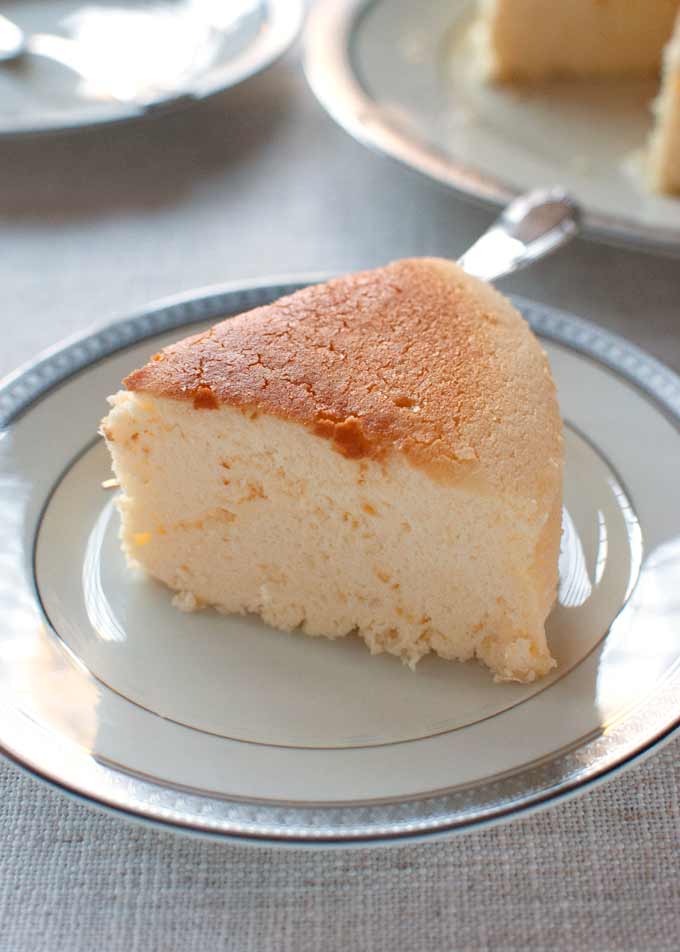 Cracked, Shrunken Cheesecake is OK
Cracked, Shrunken Cheesecake is OK
Because each oven is different, and the volume of the cake can vary even slightly, you may still end up with a cracked cheesecake.
If you are impatient and take the cake out of the oven too early, it will shrink more than the one that is slowly cooled down. But the flavour of the cake is the same and texture is only marginally less fluffy.
As my son rightly said, don’t worry about the crack and shrink. It’s still really tasty. Below is my failed Japanese Cheesecake with cracked surface (but no shrinkage!). To come to think of it, I kind of like it with cracks.
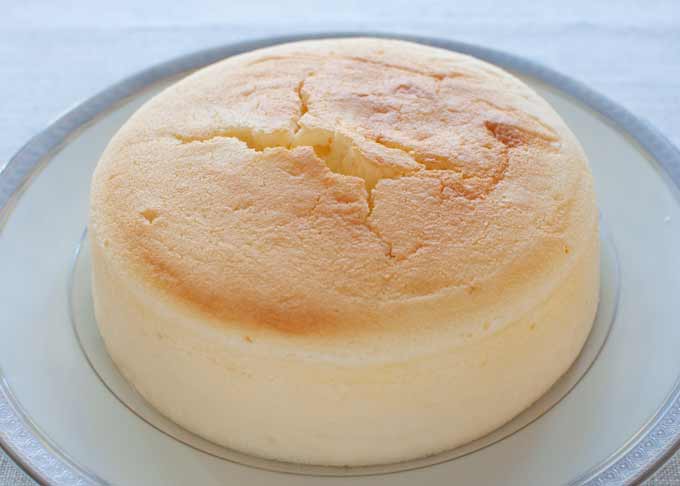
I asked my golf friends to taste test the Japanese Cheesecake that was cracked a bit. They didn’t see why I said the cake was a failure. And they all gave me the thumbs up!
It is a plain looking cake and some recipes add icing sugar or jam syrup on top. But I think that adding sweet things on top changes the characteristics of this cake. If you want to decorate the cheesecake, just sprinkle icing sugar on top to make it a bit prettier like this.
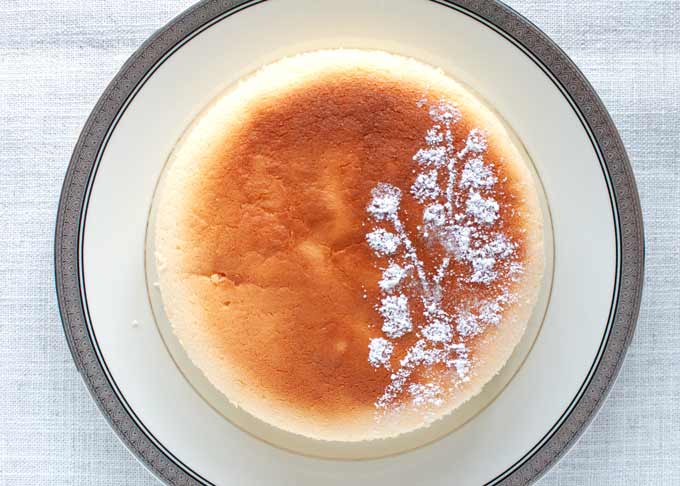
Yumiko![]()
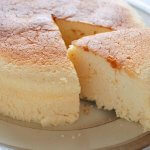
Light, fluffy, moist and less sweet than any other cheesecakes - Japanese Cheesecake is not difficult to make. But if you want to perfect it with a smooth surface and soufflé texture, you need to do a bit extra. And it's worth the effort as it's so delicious.
Time does not include the time to cool down the cheesecake on a rack.
- 250g (8.8oz, 1⅛ cups) cream cheese softened in room temperature
- 60g (2.1oz, 4¼ tbsp) butter softened in room temperature
- 35g (1.2oz, 2⅘ tbsp) sugar
- 3 egg yolks
- 2 tbsp milk
- 1 tbsp lemon juice
- ½ lemon zest (i.e. zest of a half lemon)
- 20g (0.7oz, 2⅕ tbsp) flour (all purpose) , sifted
- 10g (0.4oz, 1⅓ tbsp) cornflour (cornstarch) , sifted
- 3 egg whites
- 35g (1.2oz, 2⅘ tbsp) sugar
- 18cm (7") cake pan (note 1)
- A baking tray or a large non loose-base cake pan to comfortably fit in the cake pan , for water bath
- An oven tray or a baking tray to place a water bath tray on
- Hot water , about 80C (176F)
-
Pre-heat the oven to 160C (320F). (note 2)
-
Grease the bottom and the side of the cake pan with butter (not in ingredients) and line the bottom with baking paper (note 3).
-
If the cake pan has a loose bottom, cover the bottom and side of the cake pan with large aluminium foil (or a disposable round aluminium tray) so that the foil continuously covers the bottom and the side to just below the rim.
-
Add cream cheese in a bowl and whisk over water bath (not too hot) to soften the cream cheese. Add butter and whisk until the mixture becomes creamy with no lumps.
-
Remove the bowl from the water bath and add the remaining Batter ingredients one by one in the order of the ingredients list. Mix every time an ingredient is added. Mix well until the colour of the batter becomes consistent.
-
In a new bowl, add egg whites and beat until they become foamy.
-
Add sugar in 3-4 batches while beating the egg whites fast. Beat until soft peaks form (note 4).
-
Add a third of the meringue to the batter and fold gently using a spatula until white meringue mixes into the batter.
-
Now transfer the batter to the meringue bowl and fold gently until the trace of the white meringue disappears.
-
Pour the batter into the cake pan. Drop the pan from 10cm (4") high few times to remove air bubbles.
-
Place the cake pan in a deep baking tray or a large non loose-base cake tin. Fill hot water to 1.5cm (⅝") high (water bath).
-
Place an oven tray/baking tray on the middle rack of the oven, place the water bath tray with the cake pan inside and bake for 20 minutes.
-
Reduce the heat to 140C (284F) and bake further 40 minutes.
-
Turn off the oven and leave the cake in the oven for 30 minutes (note 5).
-
Insert a thin bamboo stick in the middle of the cake. If it comes out dry, the cake is cooked. If still slightly wet, turn the oven on to 160C (320F) and cook for 5-10 minutes.
-
Remove the cake from the water bath and gradually cool the cake down for further 20 minutes in the oven by slightly leaving the oven door by sticking the oven mitt or a cloth to the door (note 6).
-
Remove the cake from the cake tin and place the cake on a rack to cool down to room temperature.
-
Better to be served after chilling it in the fridge. (note 7)
1. It will make a cheese cake about 4.5cm (1¾”) high. If you are using a 20cm or 23 cm (8" or 9") cake pan, you may want to increase the ingredients by a quarter or a third to maintain the height of the cake (a third is easier considering the eggs). The first cooking time at 160C (320F) needs to be increased to 30 minutes but the rest of the instructions remains the same.
2. Temperature is critical. Make sure that the inside of the oven is the right temperature as some ovens have discrepancies between the actual inside temperature and what the setting indicates.
Also, I used a fan forced oven. A standard oven needs to be a bit higher but do not go too high. It is better to have a lower than required temperature than higher.
3. I don't line the side of the tin because it will leave creased mark on the side of the cake. But if you are not concerned about it, line the side of the cake tin and grease with butter.
4. Soft peaks: When you lift the whisker, the meringue forms a peak but then slowly folds. Do not beat too much or you will get a hard peak – the meringue peak does not fold and is stiff.
5. This is to prevent the inflated cake from collapsing. It also continues to cook the cake.
6. This step can be skipped if you are in a hurry, though the cheesecake might shrink a little bit.
7. Japanese Cheesecake looks attractive as it is with no decorations but if you insist, you could sprinkle icing sugar over it. The icing sugar will dissolve as time goes by so decorate just before serving.
I am not a fan of topping the cake with jam syrup or icing sugar as I believe it defeats the whole idea of lightly sweetened cake. But if you have a sweet tooth, why not?
8. Because each oven is different and the volume of the cake can vary even slightly, you may find that the surface of the baked cake is not as brown as my cake. If you wish to make it browner, you can turn the upper heat on for a short while. But don't over bake.
Hi, I would like to know whether I can use a 7 inch square deep baking tray instead? Thanks.
Hi EeLi, I have never tried with a square pan. To prevent the surface from breaking, the side of the pan needs to be smooth so that the batter can slide up easily as it inflates – the difference of the speed to lift up between the side and the centre part of the cake cause causes the cracks on the top. for that reason, the round pan is better suited. I think you can still bake it in a square pan but it might crack a bit on the surface. I would suggest that you line the side with baking paper as well. If you use a long baking paper to line the side and the bottom continuously, it will also make removal of the cake from the pan easier.
Please let me know how you went.
Hi Yumiko, do you know if anyone has tried baking this cheesecake in steam convection oven, do you think it may work as it would prevent it drying out? If no-one has tried it l will give it a go, l will wait for replies first.
Hi Rina, I certainly have no experience and don’t know anyone tried with a steam convection open. But, having said that I cannot see why you can’t. I believe you can choose different steaming settings and if you could set it to a similar steaming to a water bath, it should work.
It would be great to hear from you how it goes.
I just took my cake out of the oven. It is flat. I see that others have commented regarding this as well. Does anyone know why this has happened?
Hi Charlene, I am sorry to hear that your cake was flat. I think the mixing the meringue with the batter is the key. If you mixed too well, the small bubbles of the meringue disappears, causing the cake not to rise while baking. If not enough mixing and leaving many large bubbles, it inflates a lot but also deflate fast. Fold the mixture by scooping it with a spatula from the bottom and turning the spatula over. Even if a slight trace of white meringue is still left on the surface, that’s OK.
I hope this helps.
I purchased a seven inch pan specifically for this recipe, and it was a great investment. I’ll be making this a lot. I knew it was a good investment because it’s obvious that Nagi learned at the knee of a master, and I didn’t want it to be too eggy, I want a cake , not an omelette. I have to agree with another reviewer who put it so well, it is a keepsake.
Hi Therese, I bought the cake tin for this Cotton Cheesecake as well, since my collection of tins and utensils to bake cakes is so limited. But it was definitely worth investing for me too, having had so many great comments like yours! Thank you.
Hi Yumiko, thanks for sharing this recipe with many details. I’m wondering if I can replace sugar for powdered sugar, did you try it?
Greeting from Chile!
Hi Carolina, I have not used powdered sugar. If powdered sugar is pure sugar, I think you can use it. But if it contains cornstarch, as it often does, then it is not replaceable.
Hi Yumiko! Do you recommend using salted or unsalted butter in this recipe? I just came across your site from Nagi’s and would love to try this as I LOVE Japanese Cheesecake. I live in Toronto, Canada and there’s a cheesecake chain – Uncle Tetsu’s Japanese Cheesecake – where I would purchase from. But I’d love to learn to make it myself. Thanks!
Hi Amanda, use salted butter in this recipe. I like Japanese cakes including this cheese cake because they are not too sweet in general.
I travelled to Toronto 3 years ago. I visited many tourist places. Stayed in Barrow Bay for a couple of nights too. I came back with happy memories of Toronto and people.
Good luck with the cheese cake!
This was a great success, and on my first try too!! The cake turned out fluffy and creamy, no cracks. I only made half the recipe cz my cake tin was small. I had small eggs so used 2. Followed the instructions exactly as written. Tqtq, this recipe is a definite keepsake! ❤️
Hi Zie, that’s really great. I am very pleased for you!
Hello, I love cake that’s why I stumbled on your site. Regarding the deflated cake, have you tried to inverting the pan while cooling the cake? Hope this will help.
Hi Vir, no I haven’t! I might try that next time.
If some one needs expert view about running a blog then i recommend
him/her to pay a visit this weblog, Keep up the good job.
Thanks!
Hello! I have made it twice now; the first one was flat but tasted great, the next one was fluffy and all that good stuff. I took it to a Thanksgiving party and it was finished in a blink. Thank you very much for this wonderful recipe. I look forward to the cupcake version if you plan to update the recipe.
Hi Euqohns, that’s really great to hear that the second one was a big success. I can just imagine how happy you were to see friends scoffing your cake! I will certainly try to make the cup cake version when I find time.
I couldn’t figure out how to start my own comment so I’m replying to your reply!! Haha.
Anyway I can’t seem to bake anything here in Denver as the altitude is 6,000 ft where I’m at. I am so tired of wasting ingredients. So that being said can you recommend any adjustments for high altitude? This cake looks so tasty I want to try it. Thanks, Heidi
Hi Heidi, it’s a good question. There is no baking powder which will rise more at 6,000ft. Sugar also reacts differently and it is suggested that you need to reduce it. But given the amount of sugar is small, it can be ignored, I think. So I think that no changes are required to the ingredients.
Now baking temperature and time:various articles indicate that the temperature needs to be increased by 15-25F. Would you like to try that? It would be great if you could let me know of the results.
Hey, mine ended up flat as well 🙁 I am very disppointed as I bake regularly. I cant work out what I did wrong. Did you figure out the second time how to do it differently and what made the cake flat?
OOhh can you let me know what you did differently the second time (if any?) i just tried today and mine came flat and I wonder if it was due to my folding technique which could do with improving. Any tips you be great!!